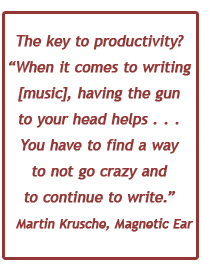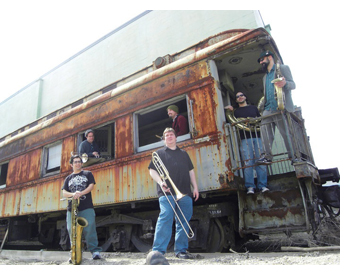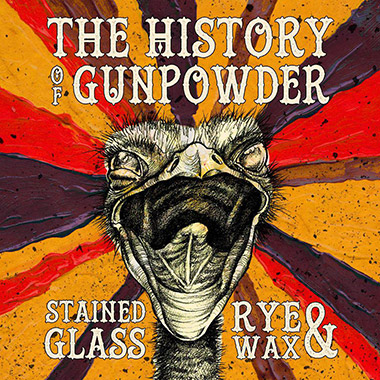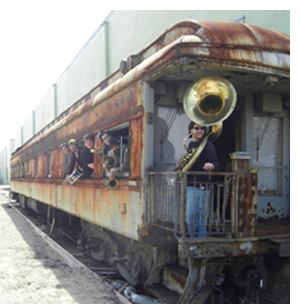 Magnetic Ear is a New Orleans pocket brass band whose members include Martin Krusche (tenor sax), Michael Watson (trombone), Wes Andersonn IV (trombone), Dan Oestreicher (baritone sax), Jason Jurzak (sousaphone), and Paul Thibodeaux (drums). Rooted in the brass band tradition (in particular the New Orleans second line tradition), the band incorporates an eclectic host of musical influences in its dynamic, danceable sound. It has recently released its third CD, Aliens of Extraordinary Ability (see the Voice review here), and has embarked on a tour of the US and Europe.
Magnetic Ear is a New Orleans pocket brass band whose members include Martin Krusche (tenor sax), Michael Watson (trombone), Wes Andersonn IV (trombone), Dan Oestreicher (baritone sax), Jason Jurzak (sousaphone), and Paul Thibodeaux (drums). Rooted in the brass band tradition (in particular the New Orleans second line tradition), the band incorporates an eclectic host of musical influences in its dynamic, danceable sound. It has recently released its third CD, Aliens of Extraordinary Ability (see the Voice review here), and has embarked on a tour of the US and Europe.
Recently, Martin Krusche?the band’s leader, tenor sax player, and composer? took the time to answer Wanda Waterman’s questions about the differences between jazz and brass band and where Magnetic Ear fits into the glorious hodgepodge of New Orleans music.
Beginnings
Magnetic Ear started as a trio and progressed to a five-piece jazz band?and from there to much more of a brass band than we’ve ever been since we’ve added another trombone and are now a six-piece band. Because we’ve inched over to becoming a brass band, the question of jazz is a whole different question.
There is a Difference
I don’t mean to create an unnecessary separation, but the jazz band and the brass band traditions are two different things. In the broadest sense they have common roots, but they are very different animals. The brass band is a format designed for playing music in the street while parading, while second lining. The band needs to be moving while playing, so you can’t have a stationary drum set.
Brass band music comes originally from military music and consists of, in addition to the brass players, a bass drum player and a snare drummer. Along with this goes the whole culture of the second line (the first line is the band and the second line consists of the dancers who follow the music). If you are aware of that, then You’re aware of the differences between jazz, whether traditional or modern, and the brass band. These are two very different genres that have served two different cultural purposes.
We try to get as big a sound out of our small six-piece ensemble as possible, to get as close as possible to the sound of a bigger brass band. That has to do with arranging and how you spread it out to make it sound big, but That’s basically what we’re after.
This is New Orleans, and everything is dominated by brass bands. The most dominant New Orleans brass bands are the Rebirth Brass Band, the Soul Rebels Brass Band, the Hot 8 Brass Band, and the Stooges Brass Band. And then you have the more traditional brass bands like Treme Brass Band. There are also a lot of new, up-and-coming brass bands.
Our band plays in clubs, and so we have a drum set player. We also occasionally have a percussion player with us, but our format is in that aspect not completely true to the classic brass band format, where you have a separate bass drummer and snare drummer. We are a little bit of a hybrid, if you will. The Dirty Dozen band is similar in that sense . . . they have a drum set player and not the divided section between bass and snare drum.
Do You Make ?em Dance?
Yes, That’s a big part of what we’re trying to do. In the broadest sense, we’re trying to play exciting, hip dance music.
I think for a long time we’ve been in a place where we’re free about where we’re getting our inspiration from, and that goes for other brass bands as well; everybody covers whatever they like. So we do a mix of original music influenced by all different styles and/or different covers that we like. In that sense we’re completely in the tradition of brass bands, and I’ve never heard anybody taking issue with us being eclectic. We’ve never tried to be anything other than an entertaining, danceable, interesting band.
On Writing Music for a Brass Band
Duke Ellington said that if it wasn’t for deadlines, there wouldn’t be any written music. I wrote a lot of music when we decided to make this last record. When it comes to writing, having the gun to your head helps.
 You have to find a way to not go crazy and to continue to write. You enter a process where you get used to returning to your pieces every day. Maybe You’re writing multiple pieces at the same time and switching back and forth; if you run out of inspiration here, you go over there. That’s when You’re in an intense writing period, which I had leading up to the making of that record.
You have to find a way to not go crazy and to continue to write. You enter a process where you get used to returning to your pieces every day. Maybe You’re writing multiple pieces at the same time and switching back and forth; if you run out of inspiration here, you go over there. That’s when You’re in an intense writing period, which I had leading up to the making of that record.
Other than that, there’s simple inspiration that hits you . . . if you have a lucky day, you have a great idea That’s the start of a song or something. But with the music that we play, there’s a moment of an idea and you have your inspiration, but you work it out, you flesh it out, because It’s not just the original idea. You also need to arrange that idea.
It’s different from writing for the jazz combo. Every member of this band has some music in front of him when he first starts playing the original composition. When you write for a jazz band, writing the chords and the melody suffices. Everybody knows what to do with it. If you give a bass player in a jazz band a chart, that chart contains the melody and the chords and the man knows what to do with it. So will the drummer and the piano player . . . and so on and so forth. But in the case of the brass band, everyone has to have his own particular harmony part, and It’s something that you might work on some more when you put the music to everybody. It’s still something that has to be written out in every last bit for everybody.
(To be concluded next week.)


